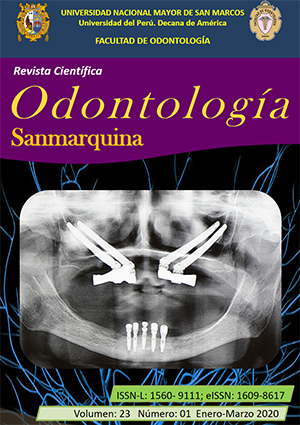Severity of dehiscences and fenestrations in ortho-surgical patients with Class III malocclusion evaluated with cone beam computed tomography
DOI:
https://doi.org/10.15381/os.v23i1.17500Keywords:
Mandibular condyle, Cone-beam computed tomography, Orthognathic surgical procedures, Prognathism (source: MeSH NLM)Abstract
Objective. Determine the frequency and severity of vestibular dehiscences and fenestrations of anterior teeth in orthodontic–surgical patients with skeletal malocclusion, Angle’s Class III; evaluated with presurgical cone-beam computed tomography Methods. Thirty cone-beam computed tomographies of skeletal malocclusion Class III patients with presurgical orthodontic treatment; were evaluated. The sample consisted of on – probabilistic and consecutive cases seen at the Universidad Nacional Mayor de San Marcos Dental School and at the Guillermo Almenara Irigoyen National Hospital’s Dental Service in Lima, Perú in 2018. The dehiscence was considered as the apical migration of the alveolar margin bone starting at 2 mm from the cementoenamel junction, and the fenestration was considered as the exposure of the root portion, excluding the alveolar margin bone; starting at 0.5 mm. Results. Out of all tomographies, 43.3% were from women and 56.7% were from men. Dehiscences were observed in all tomographies, most frequently in the mandible (91.6%) and inferior canines (100%). Fenestrations were observed in 66.7%, most frequently in the maxilla (28.3%) and maxillary canines (31.7%). The severe level was more frequently in dehiscences (65.8%) and fenestrations (13.9%), affecting the inferior canines (100%) and maxillary canines (26.7%), respectively in each defect. Conclusions. Dehiscences were observed in all tomographies, affecting most frequently mandible canines in severe level and fenestrations were observed in most tomographies, affecting most frequently maxillary canines in severe level.
Downloads
Downloads
Published
Issue
Section
License
Copyright (c) 2020 Carol del Pilar Vásquez Cabrejos, Percy Romero Tapia, Gianmarco Rivas Romero, Gabriela Sedano Balbin

This work is licensed under a Creative Commons Attribution-NonCommercial-ShareAlike 4.0 International License.
AUTHORS RETAIN THEIR RIGHTS:
a. Authors retain their trade mark rights and patent, and also on any process or procedure described in the article.
b. Authors retain their right to share, copy, distribute, perform and publicly communicate their article (eg, to place their article in an institutional repository or publish it in a book), with an acknowledgment of its initial publication in the Odontología Sanmarquina.
c. Authors retain theirs right to make a subsequent publication of their work, to use the article or any part thereof (eg a compilation of his papers, lecture notes, thesis, or a book), always indicating the source of publication (the originator of the work, journal, volume, number and date).




















